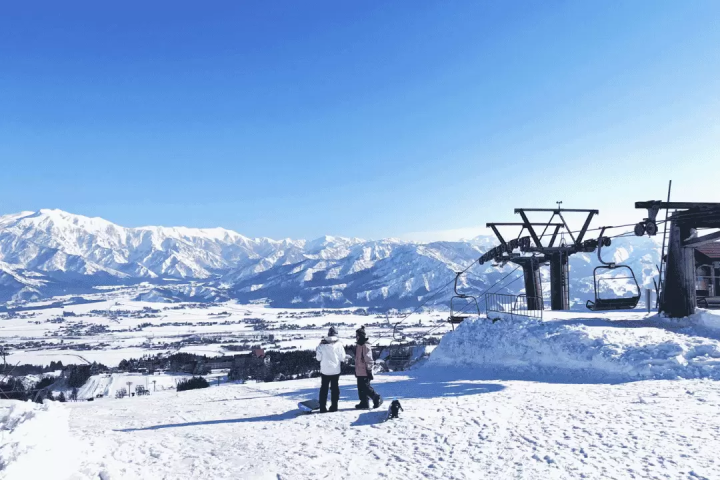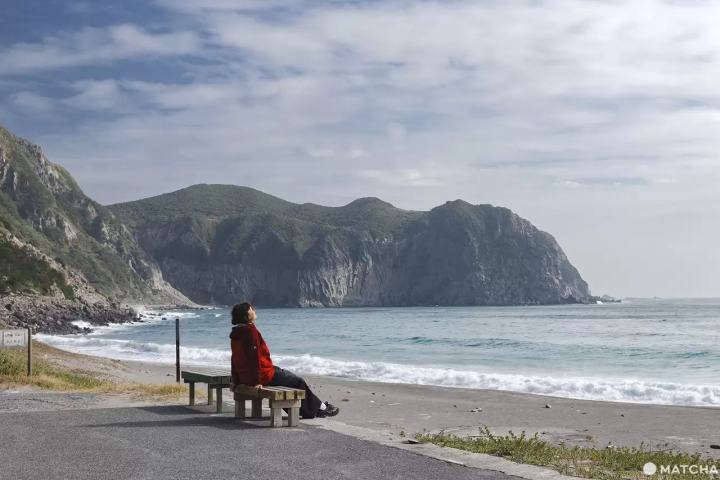7 Hot Spring Resorts Near Tokyo and Recommended Ryokan Inns

Did you know that many hot springs in Japan are within easy reach of Tokyo? You can choose from a variety of hot springs, and many places have great views and a resort-like feel. Today we feature good day-trip spots and also little-known hideaways.
Hot Springs Near Tokyo
Japan is known for being a country of hot springs. However, the Greater Tokyo area and the Kanto region, with its great access from Narita Airport and Haneda Airport―the gateways to Japan―are also dotted with many unique onsen.
At the top of the list is Gunma Prefecture which is known for the hot springs in Kusatsu Onsen. Along with Kanagawa and Tochigi, all three prefectures are home to hot springs that are famous throughout Japan. Many of these spots are accessible by day trip and one-way travel time from Tokyo is only about two hours.
Top 7 Hot Spring Resorts near Tokyo
In addition to several active volcanoes, eastern Japan has geological factors such as stratum layers that have stored ancient seawater. So the area has all the necessary elements for hot springs to flow.
Next, we will introduce these hot spring areas, all of which have convenient access from greater Tokyo.
7 Hot Spring Resorts Near Tokyo and Recommended Ryokan Inns
1. Kusatsu Onsen in Gunma
2. Shima Onsen in Gunma
3. Manza Onsen in Gunma
4. Yunishigawa Onsen in Tochigi
5. Kinugawa Onsen in Tochigi
6. Gora Onsen in Kanagawa
7. Kamogawa Onsen in Chiba
Enjoy Little-Known Hidden Ryokan Inns near Tokyo
8. Kusatsu Onsen: Kirishimaya Ryokan
9. Shima Onsen: Sekizenkan Kashotei Sanso
10. Manza Onsen: Manza Onsen Nisshinkan
11. Yunishigawa Onsen: KAMENOI HOTEL Nikko Yunishigawa
12. Kinugawa Onsen: Hotel Sunshine Kinugawa
13. Gora Onsen: Gora Kansuiro
14. Kamogawa Onsen: Kamogawa Grand Hotel
1. Kusatsu Onsen in Gunma

Photo by Pixta
Kusatsu Onsen sits at the foot of famous Mt. Kusatsu-Shirane.
It was said these were discovered in the 1st century AD, so this is a famous hot spring that's been known since ancient times. Along with Hyogo Prefecture's Arima Onsen and Gifu Prefecture's Gero Onsen, Kusatsu Onsen is ranked as one of Japan's Top Three Onsen (sanmeisen).
Kusatsu Onsen is said to have Japan's largest volume of flowing hot spring water.
The spring water exceeds 50 degrees Celsius. To make bathing possible without losing any of its positive effects, long wooden paddles have been used to stir and cool down the water in a traditional method called yumomi. These days, yumomi shows are held for sightseeing visitors, but bathing water is usually cooled down by letting it flow through wooden gutters at a spot called Yubatake.
The spring waters are categorized into acidic springs, sulfide springs, aluminum springs, sulfide salt springs, and chloride springs. The high acidity will apparently kill bacteria on the skin within 10 minutes.
The spring waters are said to be effective for skin conditions (ie. atopic dermatitis, psoriasis vulgaris), stiffness, lower back pain, fatigue, and mental health symptoms. So in additon to vacationers, many others come here for hot spring therapy treatments.
Here there are many highlights including Yubatake, or hot springs field, where the equivalent of 20 drum cans of spring water gush out every minute. There's also Sainokawara Park where Kusatsu's hot spring waters flow into the rivers and ponds.
Nearby you'll also find leisure spots such as Tenguyama Play Zone, known for its ski hill and beautiful autumn leaves.
Official Homepage: Kusatsu Onsen
↑ Return to the top of article.
2. Shima Onsen in Gunma
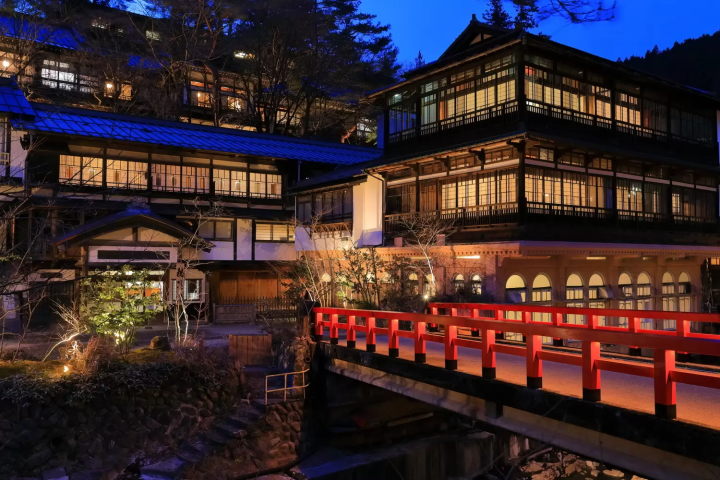
Photo by Pixta
Shima Onsen is an onsen facility in Gunma Prefecture. Rainwater in the volcanic region of the Mikuni Mountain Range, more than 10 kilometers away, has been heated underground for over 50 years and gushes out as hot spring water.
This famous hot spring was said to be known at least as far back as 1650 at the end of the Sengoku Period (Warring States Period). It was also Japan's first hot spring to receive the National Designation of a Hot Spring Health Resort.
Shima Onsen is home to Sekizenkan, Japan's oldest surviving hot spring inn (established in 1694) and one of the models for the bathhouse in the famous Ghibli film, "Spirited Away." It's also a hideaway spot that's within access from Tokyo.
The waters are a sodium-calcium, chloride, and sulfide salt spring. The water here is drinkable and is said to effective for stomach and intestinal disorders. There are several water fountains on the onsen premises.
Official Homepage: Shima Onsen
Read also
↑ Return to the top of article.
3. Manza Onsen in Gunma

Photo by Pixta
Manza Onsen is a hideaway onsen spot sitting at an altitude of 1,800 meters in a steep location.
It's located on Mt. Kusatsu-Shirane above the mountain's base where the previously mentioned Kusatsu Hot Springs are. The source for the hot springs in Manza Onsen is also from Mt. Kusatsu-Shirane.
There are many open-air baths (rotemburo) where visitors can enjoy a great view. In the fall there's the brilliant autumn foliage, and in the winter you can enjoy the soothing spring waters amidst a snowy landscape.
These springs, which are sulfurous and have a source that's 80 degrees Celsius, gush out at the rate of 5.4 million liters per day. The hot spring waters are said to be good for joint pain, chronic digestive problems, and gynecological disorders, and offer skin-beautifying effects as well.
There's also a ski hill nearby. So after an enjoyable day of skiing and snowboarding, we recommend going for a relaxing dip in the hot spring bath.
Official Homepage: Manza Onsen (Japanese)
Read also
↑ Return to the top of article.
4. Yunishigawa Onsen in Tochigi
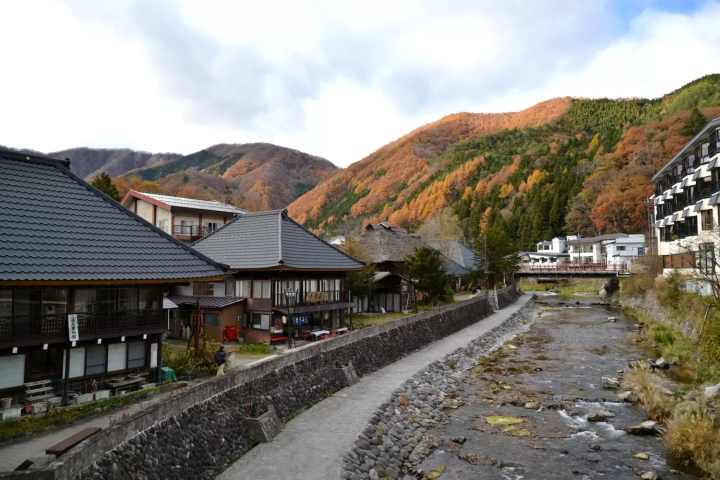
Photo by Pixta
Yunishigawa Onsen is an ancient hot spring resort located next to Gunma in Tochigi Prefecture. It was said that relatives of the Heike clan, who were defeated in the Battle of Dannoura in 1185, fled here and discovered the springs while in hiding.
The Yunishigawa River is a branch of the Tonegawa River, one of the Kanto areas's main rivers. A groundwater-type hot spring flows up along the valley formed by the Yunishigawa River. Visitors here can enjoy the hospitality of a traditional hot spring inn.
This is a gentle, simple hot spring. It's said to be effective for nervous disorders, joint disease, fatigue and for improving overall health.
The resort faces a clear stream in the mountains, allowing dinner guests to savor the taste of freshwater fish and edible wild plants. This place is associated with the Heike clan, so it's also perfect for history buffs.
Official Homepage: Yunishigawa Onsen
↑ Return to the top of article.
5. Kinugawa Onsen in Tochigi
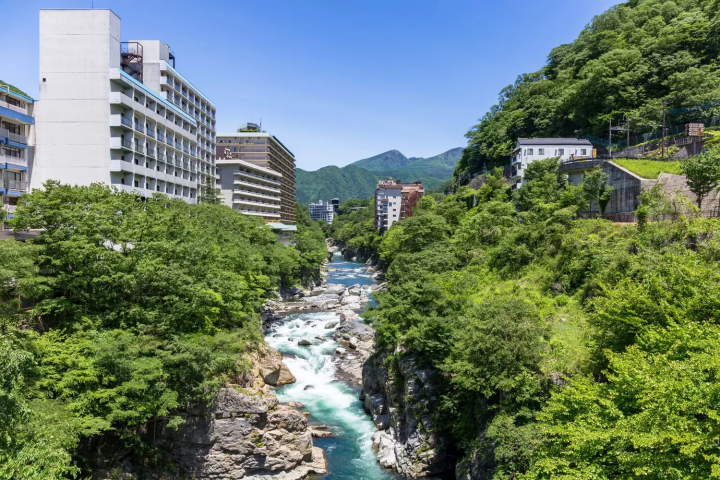
Photo by Pixta
Kinugawa Onsen is situated close to the temples and shrines of Nikko, including World Heritage Site, Nikko Toshogu Shrine. It's located in an area where visitors can enjoy sightseeing at the same time.
This is a spot with a long history. Dating back to the Edo Period (1603-1868), Buddhist monks and feudal lords stopped in here on their return from pilgrimages to Nikko.
Kinugawa Onsen has easy access from Tokyo. By train it takes less than two hours.
These hot spring waters flow out from a rift valley which the Kinugawa River (Tonegawa River's main tributary) passes through. Though the details are not fully understood, the prevailing theory suggests that this process is non-volcanic and not related to volcanic activity.
This is a simple hot springs with slightly alkaline waters. It's famous for its effectiveness in treating burns. It's also said to be good for the central nervous system, skin disorders, as well as stomach and intestinal disorders.
Official Homepage: Kinugawa Onsen
↑ Return to the top of article.
6. Gora Onsen in Kanagawa
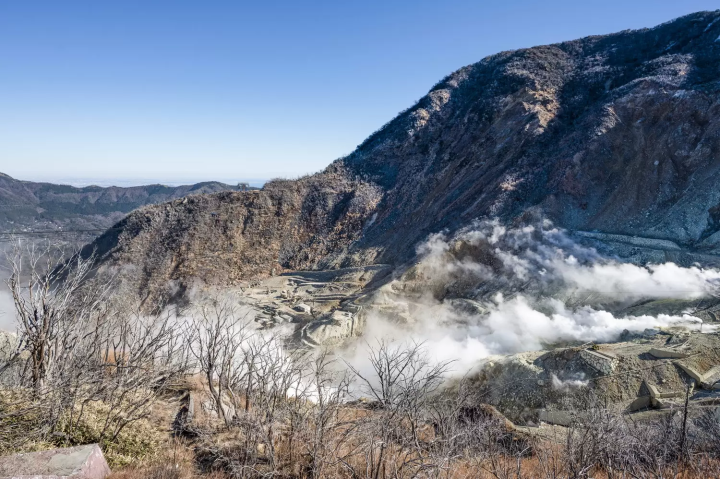
Photo by Pixta
Gora Onsen is located in Kanagawa Prefecture's Hakone area.
Hot spring water is drawn from Mt. Sounzan and Owakudani in the still-active Hakone volcano, and is also extracted through drilling. As a result, it's famous for offering visitors five different colors of spring water: clear, milky-white, pale yellow, brownish-red, and green.
Also called five-color pastel, the spring quality and efficacy of these waters vary. They include simple hot springs, sodium chloride springs, sodium solfate springs, calcium sulfate springs, and acidic sulfate springs.
This hot spring resort is located in Hakone, an area with many sightseeing attractions. It's easy to get here from Tokyo, including by shinkansen.
One of the sights of summer is the 2,000 fireworks that are set off in conjunction with the Daimonji-yaki bonfires.
Official Homepage: Gora Onsen
Read also
↑ Return to the top of article.
7. Kamogawa Onsen in Chiba
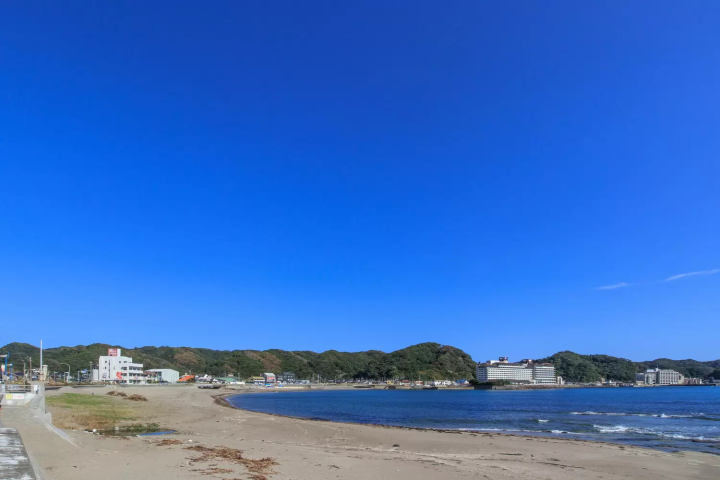
Photo by Pixta
Chiba Prefecture is not a volcanic region and there are no hot springs that emit steam. However, there are many low-temperature springs (mineral springs) that are sourced from an abundance of groundwater that's geothermally heated.
Among these is Kamogawa Onsen in the Minami Boso area. This is a relatively new hot spring that was established in 2003 by deep drilling. It's a popular spot because of its location along the coast and its resort atmosphere.
It's mainly a bicarbonate spring and is famous as a beauty hot spring that improves the condition of the skin. In addition, it's said to be effective for cuts, peripheral circulatory disorders, poor circulation, and dry skin.
Nearby, you can enjoy marine sports and also see dolphin shows at Kamogawa Sea World.
Official Homepage: Kamogawa Onsen (Japanese)
Read also
↑ Return to the top of article.
Enjoy Little-Known Hidden Ryokan Inns near Tokyo
Though the Kanto Region has a strong image of modern tourism development, surprisingly it also has a variety of accommodation options, including long-established ryokan and hotels with a resort feel. It's also close to Tokyo, making this an ideal spot for relieving the stress and fatigue of daily life.
1.Kusatsu Onsen: Kirishimaya Ryokan

Picture courtesy of Booking.com
Kirishimaya Ryokan was named after a restaurant called Kiriya, which was mentioned in a travel journal by writer Jippensha Ikku during the Edo Period. Former prime ministers, foreign ambassadors, and other notable people have all stayed at this historic inn.
The guest rooms are traditional and tasteful, and they've also tried to incorporate new ideas including a manga comic room.
There are three types of hot spring waters: high temperature, medium temperature, and lukewarm. They were designed to accommodate all guests―from those who like hot water to those people with heart conditions. There's also an open-air bath (rotemburo) that can be reserved for free.
Kirishimaya Ryokan
Access: 10 minutes on foot from Kusatsu Hot Springs Bus Terminal. 25 minutes by bus from Naganohara-Kusatsuguchi Station.
Location: Gunma, Agatsuma, Kusatsu, Ojikusatsu 541
Check-in / Check-out: 14:00-22:00 / 10:00
↑ Return to the top of article.
2.Shima Onsen: Sekizenkan Kashotei Sanso

Picture courtesy of Booking.com
Sekizenkan Kashotei Sanso is a traditional ryokan where visitors can experience the impressive architecture of Japan's oldest surviving hot spring inn.
Guests can choose to stay in one of three separate buildings: the main building (Honkan) which preserves ancient traditions; the Sanso building, a nationally registered cultural property that was built in the Momoyama architectural style; and the Kashotei building which is located on higher ground and enveloped in peace and tranquility.
The ryokan still serves as a spot for spa treatments (toji), so healthy medicinal food and tea is served for lunch. At dinner you can enjoy Japanese-style banquet cuisine using lots of fresh ingredients. Then afterwards, take a relaxing dip in the open-air bath.
It's also possible to use the hot spring baths on a day trip. This traditional ryokan needs to be experienced at least once.
Sekizenkan Kashotei Sanso
Access: About 40 minutes by bus from Nakanojo Station
Location: Gunma, Agatsuma, Nakanojo, Shima-Ko 4236
Check-in / Check-out: 15:00-18:00 / 11:00
↑ Return to the top of article.
3. Manza Onsen: Manza Onsen Nisshinkan
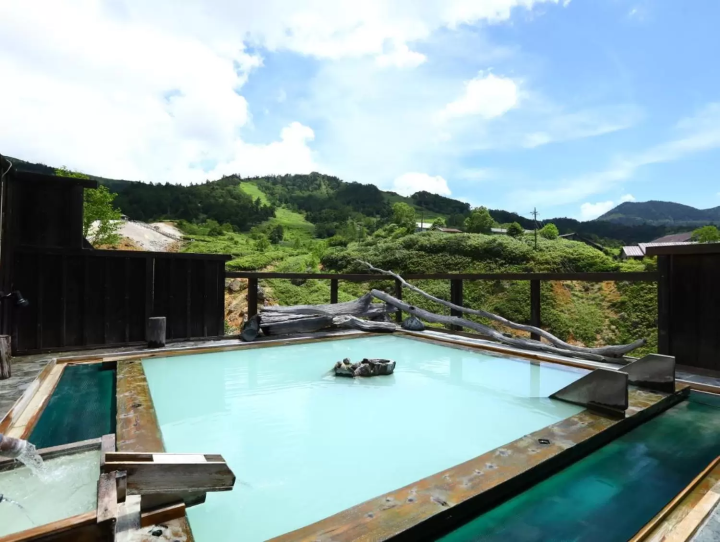
Picture courtesy of Booking.com
Manza Onsen Nisshinkan is a ryokan sitting at an elevation of 1,800 meters, located inside a National Park surrounded by abundant nature.
Nisshinkan has three different buildings: the main building (Honkan), the annex building (Bekkan), and the new building (Yubo). The ryokan offers a wide range of room types including guest rooms with stunning views, as well as guest rooms for long-stay visitors who are receiving spa treatments.
There are many bathing options including a large public bath where you can enjoy four kinds of hot springs, a bath that can be reserved for private use, an open-air bath with great views of nature, and a bath (also with a view) that's made with natural cypress wood (hinoki). You can also enjoy these hot springs on a day trip.
Meals combine Japanese and Western cuisine and are served buffet style. Diners here can savor a wide range of culinary delights.
Manza Onsen Nisshinkan
Access: About one hour and 45 minutes by bus from Karuizawa Station. About 40 minutes by bus from Manza-Kazawaguchi Station. A complimentary shuttle bus (reservations required) leaves from both of the above stations.
Location: Gunma, Tsumagoi, Hoshimata, Manza Onsen 2401
Check-in / Check-out: 15:00 / 10:00
↑ Return to the top of article.
4.Yunishigawa Onsen: KAMENOI HOTEL Nikko Yunishigawa

Picture courtesy of Booking.com
KAMENOI HOTEL Nikko Yunishigawa is a reasonably-priced hotel where guests can enjoy nearby Yunishigawa Hot Springs.
The hotel has a modern interior and in the guest lounge there are complimentary soft drinks as well as wine and sake for an extra fee.
Dinner consists of banquet-style wild game (jibie) prepared at an irori, a traditional Japanese sunken hearth filled with charcoal. Diners can savor the bounty from the mountains in a way that's not available anywhere else.
Guests can enjoy various hot springs at the large public bath, and there's also a sauna. Day trippers are also free to use the hot springs.
KAMENOI HOTEL Nikko Yunishigawa
Access: About 20 minutes by car from Yunishigawa Onsen Station. On weekdays a complimentary shuttle bus leaves from Yunishigawa Onsen Station.
Location: Tochigi, Nikko, Yunishigawa 1033
Check-in / Check-out: 15:00-22:00 / 10:00
↑ Return to the top of article.
5.Kinugawa Onsen: Hotel Sunshine Kinugawa
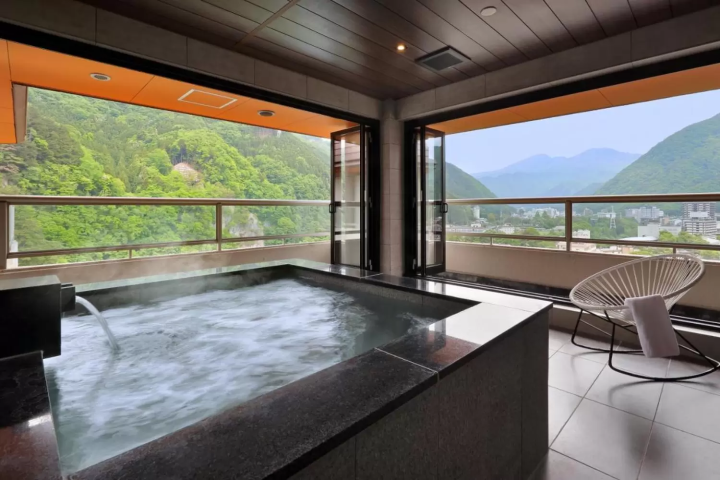
Picture courtesy of Booking.com
Hotel Sunshine Kinugawa overlooks the Kinugawa River and majestic mountains.
The guest rooms have magnificent views of the Kinugawa River, and there are also rooms where guests can soak in their own open-air bath as they gaze out at the Kinugawa Valley down below.
The large public bath, which is great for day trips, also has an open-air bath offering beautiful scenery with the valley in the background. There's also a sauna, so this hotel is perfect for people who'd like to experience a variety of hot springs.
Hotel Sunshine Kinugawa offers three dining options: a semi-private dining room, a dining room, and a buffet. This hotel can be enjoyed by everyone, from adults to families.
Hotel Sunshine Kinugawa
Access: About six minutes by bus from Kinugawa Onsen Station.
Location: Tochigi,, Nikko, Kinugawa Onsen, Ohara 1437-1
Check-in / Check-out: 15:00-18:00 / 10:00
↑ Return to the top of article.
6.Gora Onsen: Gora Kansuiro
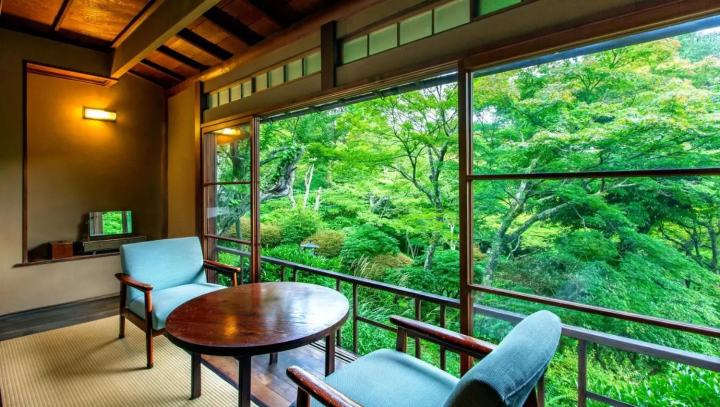
Picture courtesy of Booking.com
Gora Kansuiro is a famous inn loved by many notable people including Emperor Showa and Empress Kojun.
The traditional guest rooms, in service since the Taisho Period (1912-1926), have views of a Japanese-style garden (about 178,000 square feet).
All rooms are Japanese-style and were thoughtfully designed to allow for a traditional Japanese experience.
The hot springs consist of open-air baths and communal baths which have a nostalgic feel to them. The open-air baths offer beautiful seasonal views: the fresh green foliage in spring, the clear blue skies of summer, the autumn leaves in the fall, and the snowy landscapes in winter.
Gora Kansuiro
Access: About three minutes on foot from Gora Station.
Location: Kanagawa, Hakone, Gora 1300-20
Check-in / Check-out: 15:00-21:00 / 7:00-10:00
↑ Return to the top of article.
7.Kamogawa Onsen: Kamogawa Grand Hotel
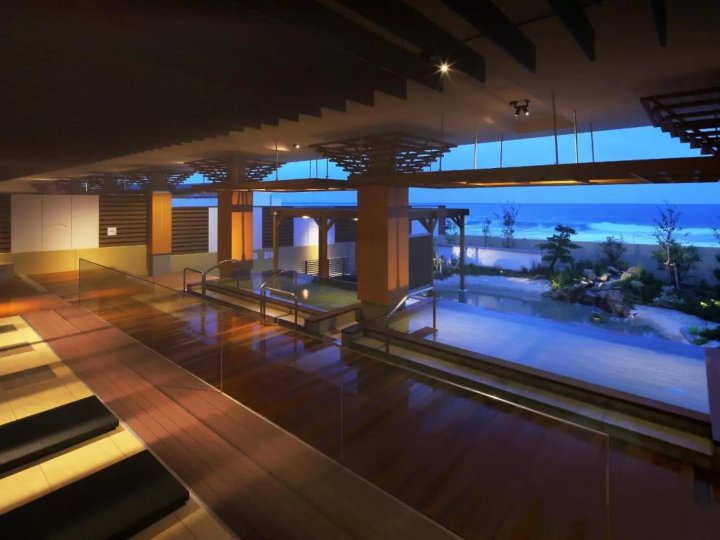
Picture courtesy of Booking.com
The Kamogawa Grand Hotel, with its resort-like atmosphere, overlooks the Tojo coast and is known for its exquisite sunrises and marine sports.
Rooms offer an ocean view or forest view, and both have their own distinctive feel.
The hot springs can also be enjoyed by day trip. There's a large public bath that has bedrock bathing (ganbanyoku), and also open-air baths which can be reserved. Both types have stunning views of the Pacific Ocean, so take in the scenery as you relax in the soothing spring waters.
Both breakfast and dinner are buffet-style. There's a wide range of tasty cuisine including fresh seafood dishes that are only available at a coastal resort like this.
Kamogawa Grand Hotel
Access: About 10 minutes on foot from Awa-Kamogawa Station
Location: Chiba, Kamogawa, Hiroba 820
Check-in / Check-out: 15:00-18:00 / 10:00
↑ Return to the top of article.
Enjoy Hot Spring Areas and Ryokan near Tokyo
Even the Kanto Region, which forms greater Tokyo, has many hot spring areas ranging from famous spots all the way to little-known hideaways. Whether you have a relaxing overnight stay or take a reasonably-priced day trip, you can fully enjoy all of these.
Here you'll discover a wide variety of hot springs. If you'd like to receive a spa treatment you can choose the one most effective for you, or you can also experience facilities with a rich tradition and history, or have a relaxing dip as you enjoy the scenic views.
Please feel free to visit one of these hot spring resorts by making use of the convenient access, then treat your mind and body to a soothing experience!
↑ Return to the top of article.
Read also
Main image courtesy of Booking.com
Written by Kakutama editorial team
This is the official account of MATCHA's editorial department. Our articles feature useful travel information for visitors to Japan, from how-to guides to recommended places to visit.














































![[30 minutes by train from Meitetsu Tokoname Station!] A must-see for couples! Recommended date Feature Articles in Aichi Prefecture](https://resources.matcha-jp.com/resize/720x2000/2025/12/19-253428.webp)
